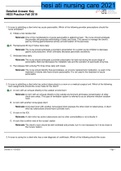Exam (elaborations)
ADULT HESI CUMULATIVE QUESTIONS AND ANSWER KEY FALL
- Course
- ADULT HESI
- Institution
- Tarrant County College
A nurse is admitting a client who has acute pancreatitis. Which of the following provider prescriptions should the nurse anticipate? A. Initiate a low-residue diet. Rationale: One of the manifestations of acute pancreatitis is abdominal pain. The nurse should anticipate the provider will prescr...
[Show more]



